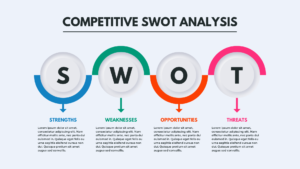Are you tired of feeling like your SEO efforts are falling short? It’s time to adopt a new strategy and begin utilizing SWOT analysis to your benefit.
Let’s speak facts here! It can be difficult to play the game of SEO, with search algorithms constantly changing and competition growing fiercer by the day, it can be tough to stay ahead of the game.
But fear not! By using SWOT analysis, you can gain a clearer understanding of your business’s strengths, weaknesses, opportunities, and threats, giving you the edge you need to succeed in the world of SEO.
Don’t worry if you’re not familiar with SWOT analysis; we’ll break it down for you and show you how to apply it to your SEO strategy.
We’ll provide you with useful advice and examples from the real world in this article to get you started with SWOT analysis for SEO. So let’s dive in and unlock the power of SWOT analysis for SEO success!
Table of Contents
TogglePerforming a SWOT Analysis for SEO
The Value of SWOT Analysis in SEO Success
Businesses must use a SWOT analysis to better understand both their internal and external environments.
A SWOT analysis for SEO will assist you in determining your company’s position in the online market, what makes you stand out from the competitors, and how to strengthen your SEO efforts. This section will discuss the benefits of completing a SWOT analysis and open your eyes into how it may help you improve your SEO strategies.
Understanding the Basics of SWOT Analysis
SWOT analysis is a structured framework for assessing the internal and external factors that impact a business. It offers a thorough and all-encompassing perspective of a company’s existing status and aids in the discovery of prospective improvement areas.
Their are four components of SWOT analysis, including:
Strengths
Strength represents the internal elements that provide your company an edge over the competition. A solid brand reputation, high-quality content, or a sizable social media following are a few examples of SEO strengths.
Weaknesses
Weaknesses are also internal elements that make your company less competitive than others. Examples of SEO shortcomings include slow website loading times, out-of-date material, and a dearth of backlinks.
Opportunities
Opportunities represent the external factors that can help your business grow and succeed. Examples of opportunities for SEO could be changes in search algorithms that favor your content or a growing demand for your products or services.
Threats
Threats are also external factors that can pose a risk to your business. Threats to SEO include things like heightened competition, unfavorable reviews, or adjustments to search algorithms that hurt your ranks.
You may utilize this information to guide your SEO strategy once you’ve determined the strengths, weaknesses, opportunities, and dangers facing your company. You may maximize your SEO efforts and get better results by utilizing your capabilities, fixing your shortcomings, grabbing chances, and minimizing dangers!

SWOT and Competitive Advantage
Businesses can use SWOT analysis to pinpoint areas where they have an advantage over their competitors, which can help them develop SEO strategies and methods, as it can significantly improve their search rankings and expand their online visibility by recognizing and utilizing these areas of strength.
Moreover, businesses must analyze their own and their competitors strengths and weaknesses in to identify areas of competitive advantage. For instance, a company might have a special product or service offering, a sizable social media following, or a solid brand reputation that can all be used to set themselves apart from competing in search results.
By using SWOT analysis to identify these areas of competitive advantage, businesses can tailor their SEO strategies and tactics to emphasize and promote these strengths. For example, they can focus on creating content that highlights their unique product offerings, or use social media to engage with customers and build a strong brand reputation. This can help – a lot – in increasing their online visibility and driving more traffic to their website.
SWOT and Content Optimization
SWOT analysis can help businesses identify potential content gaps and opportunities for optimization, which can improve their search rankings and visibility. By examining their internal and external environment, businesses can identify key areas where they can improve their content, including keyword research, content structure, and content quality.
Keyword research is an important component of SEO, and SWOT analysis can help businesses identify which keywords are most relevant to their target audience. By using tools such as Google Keyword Planner or SEMrush, businesses can identify popular keywords and phrases that they should target in their content.
Content structure is also important for SEO, and SWOT analysis can help businesses identify areas where they can improve their website’s structure to make it more user-friendly and easier to navigate. This can include improving the site’s navigation, reducing page load times, and optimizing images and videos.
Overall
Finally, SWOT analysis and SEO are a winning combination that can assist businesses in achieving their online objectives. SWOT analysis is a structured and systematic approach to analyzing a company’s strengths, weaknesses, opportunities, and threats, which can aid in the identification of SEO priorities and opportunities.
So, don’t miss out on the benefits that SWOT analysis can bring to your SEO strategy. Start incorporating it today and unlock new opportunities for online growth and success!


